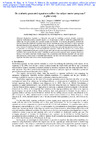Please use this identifier to cite or link to this item:
https://accedacris.ulpgc.es/handle/10553/107485
| DC Field | Value | Language |
|---|---|---|
| dc.contributor.author | Parziale, Antonio | en_US |
| dc.contributor.author | Diaz, Moises | en_US |
| dc.contributor.author | Ferrer, Miguel A. | en_US |
| dc.contributor.author | Marcelli, Angelo | en_US |
| dc.date.accessioned | 2021-06-11T10:17:27Z | - |
| dc.date.available | 2021-06-11T10:17:27Z | - |
| dc.date.issued | 2017 | en_US |
| dc.identifier.isbn | 9788864387062 | en_US |
| dc.identifier.uri | https://accedacris.ulpgc.es/handle/10553/107485 | - |
| dc.description.abstract | Handwritten signature is a biometric trait used for verifying a person’s identity. Automatic signature verification systems typically require a lot of specimens in order to model the signing habit of a subject but, in a real scenario, few signature samples are available. To overcome this problem, methods for creating human-like duplicated signatures using one real signature per subject and based on sigma lognormal decomposition have been proposed in literature. In this paper, we evaluate if duplicated signatures show the same amount of variability observed in real signaturesby detectingand analysingsignature stability regions. In particular, we investigateif real and duplicated signatures could be the instances of a similarmotor program. Experimental results on a standard dataset show thatin some casesduplication methods introduce a variability that is greater thanthe writer's variability to such an extent to generate motor programs that do not belong to the writer's repertoire. Results suggest that a connectionexists between trajectory plan and motor plan parameters, whichcannot be modified independently one from the other in order to generate synthetic signatures that reflect the writer’smotor program repertoire. | en_US |
| dc.language | eng | en_US |
| dc.publisher | International Graphonomics Society | en_US |
| dc.source | Graphonomics for e-Citizens: e-Health, e-Society, e-Education / Claudio De Stefano, Angelo Marcelli (Eds.), p.119-122 | en_US |
| dc.subject | 2405 Biometría | en_US |
| dc.title | Do synthetic generated signatures reflect the subject motor programs? A pilot study | en_US |
| dc.type | info:eu-repo/semantics/conferenceobject | en_US |
| dc.type | ConferenceObject | en_US |
| dc.relation.conference | 18th Conference of the International-Graphonomics-Society (IGS 2017) | en_US |
| dc.description.lastpage | 122 | en_US |
| dc.description.firstpage | 119 | en_US |
| dc.investigacion | Ingeniería y Arquitectura | en_US |
| dc.type2 | Actas de congresos | en_US |
| dc.description.numberofpages | 4 | en_US |
| dc.utils.revision | Sí | en_US |
| dc.date.coverdate | 2017 | en_US |
| dc.identifier.ulpgc | Sí | en_US |
| dc.contributor.buulpgc | BU-BAS | en_US |
| item.grantfulltext | open | - |
| item.fulltext | Con texto completo | - |
| crisitem.event.eventsstartdate | 18-06-2017 | - |
| crisitem.event.eventsenddate | 21-06-2017 | - |
| crisitem.author.dept | GIR IDeTIC: División de Procesado Digital de Señales | - |
| crisitem.author.dept | IU para el Desarrollo Tecnológico y la Innovación | - |
| crisitem.author.dept | Departamento de Física | - |
| crisitem.author.dept | GIR IDeTIC: División de Procesado Digital de Señales | - |
| crisitem.author.dept | IU para el Desarrollo Tecnológico y la Innovación | - |
| crisitem.author.dept | Departamento de Señales y Comunicaciones | - |
| crisitem.author.orcid | 0000-0003-3878-3867 | - |
| crisitem.author.orcid | 0000-0002-2924-1225 | - |
| crisitem.author.parentorg | IU para el Desarrollo Tecnológico y la Innovación | - |
| crisitem.author.parentorg | IU para el Desarrollo Tecnológico y la Innovación | - |
| crisitem.author.fullName | Díaz Cabrera, Moisés | - |
| crisitem.author.fullName | Ferrer Ballester, Miguel Ángel | - |
| Appears in Collections: | Actas de congresos | |
Page view(s)
201
checked on Sep 28, 2024
Download(s)
25
checked on Sep 28, 2024
Google ScholarTM
Check
Altmetric
Share
Export metadata
Items in accedaCRIS are protected by copyright, with all rights reserved, unless otherwise indicated.
